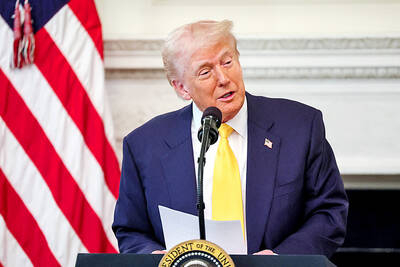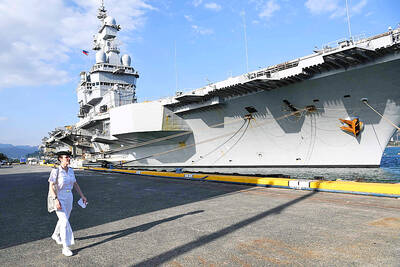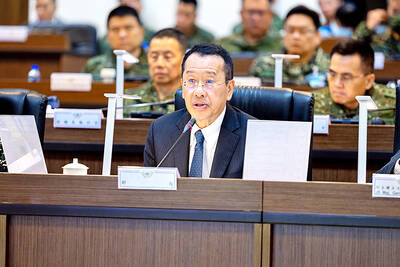The New Taiwan dollar had its biggest weekly drop in more than a year as Europe’s sovereign debt crisis prompted investors to shun emerging-market assets and favor holding US dollars.
The currency slid for a third day as the central bank intervened in the final minutes of trading to buy the US dollar, said two traders familiar with the central bank’s operations, who declined to be identified.
Overseas funds sold US$1.8 billion more Taiwanese equities than they bought in the past five days, according to stock-exchange data.
“All banks now want to sell the Taiwan dollar and buy the US dollar because of the euro area’s collapse,” said Henry Lin, a foreign-exchange trader at Taiwan Shin Kong Commercial Bank (新光銀行) in Taipei. “Some exporters may sell the US dollar at NT$31.80.”
The Taiwan dollar fell 1.4 percent this week to NT$31.850 against its US counterpart at the 4pm close on Friday, according to Taipei Forex Inc. That was the biggest weekly drop since February last year. The benchmark TAIEX slipped for a ninth day, the longest losing streak since 2005.
Other Asian currencies also tumbled this week, with South Korea’s won and the Philippine peso posting their biggest losses in more than a year as Europe’s debt crisis drove investors from riskier assets.
The MSCI Asia-Pacific Index of regional shares had its worst week since February last year and the cost of protecting the region’s corporate bonds from default rose the most in 14 months.
The won declined 4.1 percent this week to 1,155.45 per US dollar and the peso slid 2.4 percent to 45.535. Malaysia’s ringgit dropped 2.7 percent, the most since a dollar peg ended in 2005. Indonesia’s rupiah gained 0.1 percent to 9,225 yesterday, trimming its weekly loss to 2.4 percent, on suspected intervention by the central bank.
India’s rupee also pared losses yesterday on suspected intervention, after touching a two-month low of Rs45.725 per dollar. The currency declined 2.5 percent to Rs45.4800 this week.
Elsewhere, Singapore’s dollar dropped 1.9 percent this week to S$1.3933 and the Thai baht was little changed at 32.35.
The euro fell the most against the US dollar since the collapse of global credit markets in 2008 as the European Central Bank (ECB) failed to ease concern that Greece’s fiscal crisis would intensify across the region.
The common currency on Friday surged the most in nearly four weeks on speculation the ECB may come to the aid of banks threatened by Greece’s crisis in an effort to halt contagion. The yen rose the most versus the US dollar in 11 weeks as a slide in stocks reduced demand for growth-related assets. The euro zone’s economy grew 0.1 percent in the first three months of the year, according to the median of a Bloomberg survey before a report on May 12.
The euro fell 4.1 percent this week, the most since the five days ended Oct. 24, 2008, to US$1.2755, from US$1.3294 on April 30. The common currency rose 1.1 percent on Friday, its first gain in a week. It declined 6.4 percent, also the most since October 2008, to ¥116.81, from ¥124.78.
The US dollar fell 2.4 percent to ¥91.59 this week, the biggest drop since February, from ¥93.85.
The pound touched a 13-month low of US$1.4477 against the greenback as Conservative David Cameron failed to win a majority in the House of Commons, increasing concern that the UK would be unable to tackle its fiscal deficit. For the week it declined 3.1 percent to US$1.4795, from US$1.5274.

STILL COMMITTED: The US opposes any forced change to the ‘status quo’ in the Strait, but also does not seek conflict, US Secretary of State Marco Rubio said US President Donald Trump’s administration released US$5.3 billion in previously frozen foreign aid, including US$870 million in security exemptions for programs in Taiwan, a list of exemptions reviewed by Reuters showed. Trump ordered a 90-day pause on foreign aid shortly after taking office on Jan. 20, halting funding for everything from programs that fight starvation and deadly diseases to providing shelters for millions of displaced people across the globe. US Secretary of State Marco Rubio, who has said that all foreign assistance must align with Trump’s “America First” priorities, issued waivers late last month on military aid to Israel and Egypt, the

‘UNITED FRONT’ FRONTS: Barring contact with Huaqiao and Jinan universities is needed to stop China targeting Taiwanese students, the education minister said Taiwan has blacklisted two Chinese universities from conducting academic exchange programs in the nation after reports that the institutes are arms of Beijing’s United Front Work Department, Minister of Education Cheng Ying-yao (鄭英耀) said in an exclusive interview with the Chinese-language Liberty Times (the Taipei Times’ sister paper) published yesterday. China’s Huaqiao University in Xiamen and Quanzhou, as well as Jinan University in Guangzhou, which have 600 and 1,500 Taiwanese on their rolls respectively, are under direct control of the Chinese government’s political warfare branch, Cheng said, citing reports by national security officials. A comprehensive ban on Taiwanese institutions collaborating or

France’s nuclear-powered aircraft carrier and accompanying warships were in the Philippines yesterday after holding combat drills with Philippine forces in the disputed South China Sea in a show of firepower that would likely antagonize China. The Charles de Gaulle on Friday docked at Subic Bay, a former US naval base northwest of Manila, for a break after more than two months of deployment in the Indo-Pacific region. The French carrier engaged with security allies for contingency readiness and to promote regional security, including with Philippine forces, navy ships and fighter jets. They held anti-submarine warfare drills and aerial combat training on Friday in

COMBAT READINESS: The military is reviewing weaponry, personnel resources, and mobilization and recovery forces to adjust defense strategies, the defense minister said The military has released a photograph of Minister of National Defense Wellington Koo (顧立雄) appearing to sit beside a US general during the annual Han Kuang military exercises on Friday last week in a historic first. In the photo, Koo, who was presiding over the drills with high-level officers, appears to be sitting next to US Marine Corps Major General Jay Bargeron, the director of strategic planning and policy of the US Indo-Pacific Command, although only Bargeron’s name tag is visible in the seat as “J5 Maj General.” It is the first time the military has released a photo of an active